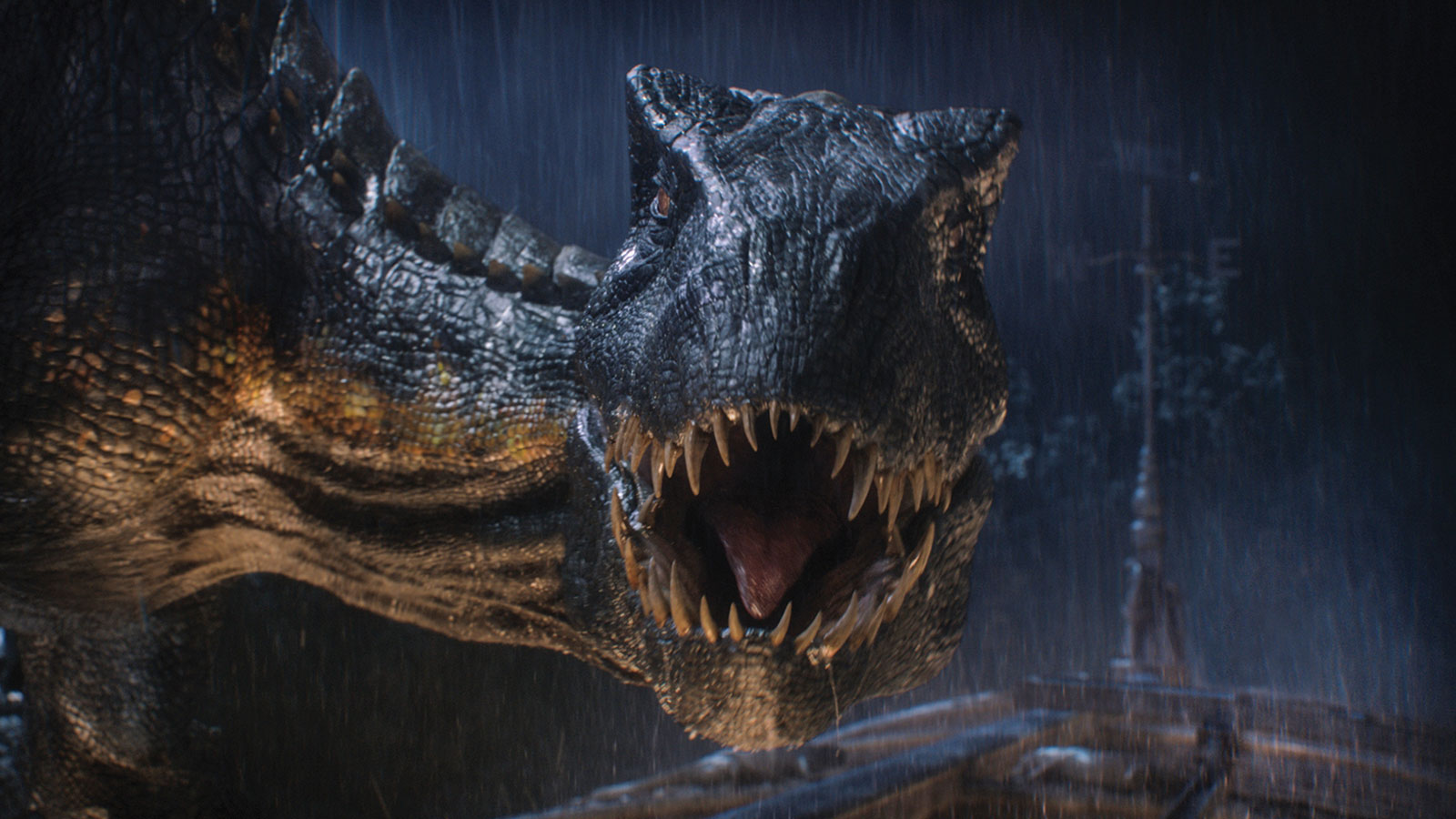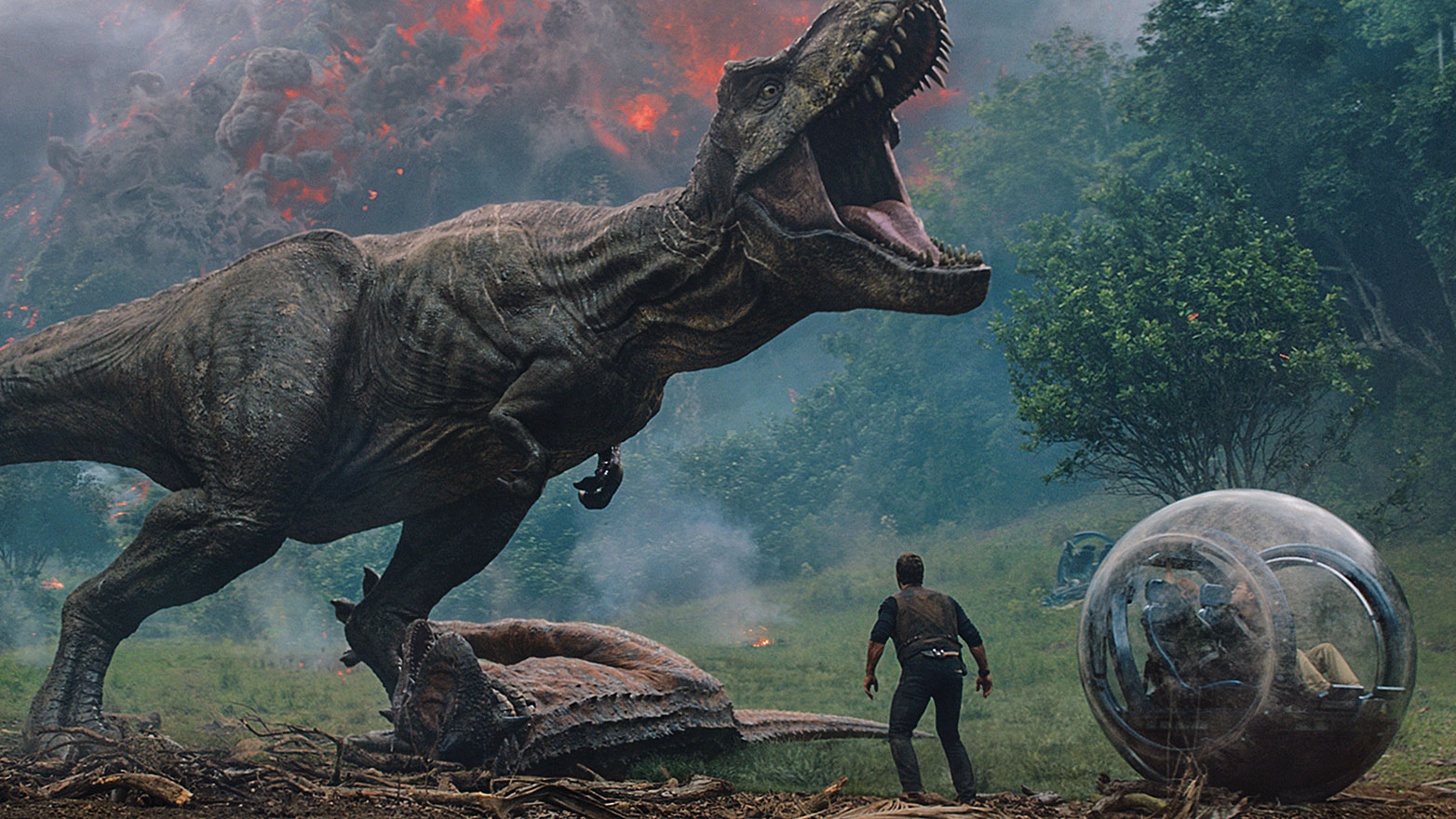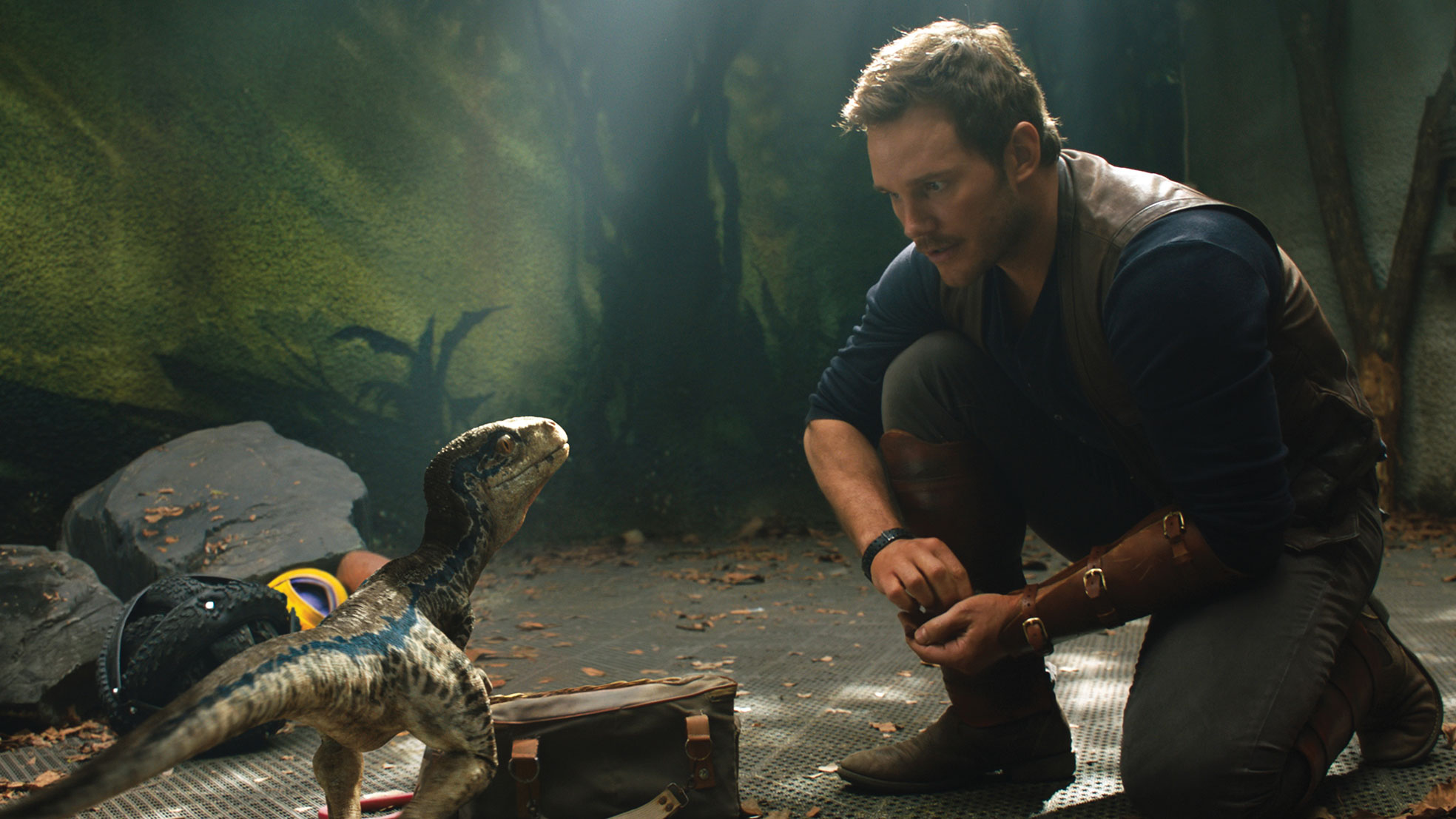Jurassic World VFX uncaged
Join us on guided tour of the visual effects in Jurassic World: Fallen Kingdom, courtesy of ILM.

In J.A. Bayona's Jurassic World: Fallen Kingdom, Owen Grady and Claire Dearing return to Isla Nublar to save the remaining dinosaurs from an erupting volcano. However, their efforts are undermined by those with more nefarious plans for the prehistoric beasts. Just under 1,200 visual effects shots were supervised by David Vickery, with help from his ILM colleagues in London and Vancouver, along with other contributors.
“We did establishing shots of Isla Nublar,” states ILM visual effects supervisor Alex Wuttke. “The challenge there was to stay true to all of the various depictions of the geography of the island that we’ve seen before, and put a big volcano in the middle of it.”
You could create little boundaries of CG vegetation around the flowing lava, which would catch light and be driven by the thermals being kicked out
Alex Wuttke, ILM
Aerial plate photography was shot of Hawaii with the wider views generated in CG. The opening sequence follows a team of mercenaries in small submersibles, on an expedition to recover the Dominus Rex bones. Powerful searchlights on the aquatic vessels assisted with the illumination of the underwater environment. “Whatever falls within the beam gets slightly less falloff than what’s outside of it. This helps with the sense of claustrophobia, because anything outside of the beams you can’t see, while things that fall within reveal themselves.”
For the thinner smoke, ILM Vancouver used Plume (an in-house ILM tool for simulations) while ILM London created pyroclastic flows in Houdini. “The volcano eruption is compressed from a real-world to a cinematic timeline, so things happen quickly,” notes Wuttke. The team built a big vegetation toolkit, which could be used for scenes involving dinosaurs knocking vegetation aside, but also for capturing lava moving through the jungle.

"You could create little boundaries of CG vegetation around the flowing lava, which would catch light and be driven by the thermals being kicked out by the lava. A lot of times we were augmenting the plate with digital vegetation to give it that interaction.”
The ILM animation team in London used simple geometry and deformers in Maya previs to ensure the lava worked properly. They established the amount of lava, where it would pour and how quickly, to enable the effects team to get their simulations moving in the correct direction.
Practical realism
A gyrosphere containing two of the characters tumbles into the ocean, leading to a long underwater shot. “Those were big and difficult effects simulations that needed to feel believable and be readable on-screen,” states animation supervisor Jance Rubinchik. “We looked at a lot of references of whales breaching and diving back down. What we found was when large objects crash into the water, you get tons of bubbles streaming off of them, which tends to obscure everything. There was a lot of back and forth trying to arrive at something that feels like you’re underwater but also isn’t hiding it too much.”
Daily design news, reviews, how-tos and more, as picked by the editors.
Every location was based on real elements. “In a lot of occasions, we created a digital version of the environment that we shot in, to give us more flexibility with the camera placement.”
You look at the anatomy of each dinosaur to figure out what real-life references you can grab to give them a unique movement
Jance Rubinchik, ILM
Wherever possible, the team tried to make use of animatronics – specialists built a whole kit of different dinosaur parts, as well as full creature builds. "There were instances of digital augmentation to give the animatronic an extra range of motion," says Wuttke. "When you have long shots and stampeding dinosaurs, we switched to fully digital versions.”
Digital files of the creatures were created at ILM and shared with Scanlan to ensure visual consistency between the CG and animatronic versions. “You look at the anatomy of each dinosaur to figure out what real-life references you can grab to give them a unique movement,” remarks Rubinchik.
“For the Stygimoloch, we looked at cassowaries and ostriches. It’s a lot of pantomime. You have to try to find what types of poses indicate what sort of emotion, and break those up to make it as clear as possible for the audience. Then you try to work in any personality stuff that you can. The Stygimolochs were always running around smashing into things, so we did a lot of little twitches, shudders and headshakes to try to make them funnier.”
New and familiar characters
“The Indoraptor was our new addition to the family of genetically engineered dinosaurs,” remarks Wuttke. “There’s a lot of Gothic and Dracula influence. We spent a lot of time at the beginning of the show working out animation cycles, making sure that we could achieve the required range of motion with the design. Indo has these long limbs and is quite skeletal, which means he can get into various contorted poses easily.”
Bayona was keen to make the genetic hybrid creature slightly psychotic, so the animation team introduced little shakes and unexpected tremors. Its black skin combined with the nighttime setting helped add to the horror and suspense. “Bayona liked the idea of not being able to see the dinosaur at times; he thinks that is scarier. It played in our favour. You get these memorable moments where you can almost see nothing and get this dark flash that reverses out of the backlight," adds Wuttke.

Making a reappearance is Blue, the female Velociraptor raised by Owen Grady. “A higher-resolution version of Blue was created with really fine detail and face shapes so we could get those extreme close-ups that Bayona was after,” remarks Rubinchik. “We wanted Blue to feel like the same character from Jurassic World, but also deepen the relationship between her and Owen."
In the film, you see how Owen's character raised Blue from a baby. "It was fun getting to explore how the baby raptors would move," adds Rubinchik. "They had to feel like a raptor but also be fun and playful, almost like puppies.” Audience expectations also needed to be addressed. “We have to be careful with a character like Blue because she is iconic and recognisable,” notes Wuttke.
Invisible effects
Along with principal photography taking place in Hawaii, sets were built at Pinewood Studios in the UK. The diorama room in Lockwood Mansion was a large set, although the team did use a lot of CG set extensions, on the exterior of the house in particular. Rubinchik explains that putting the CGI Indoraptor into the set helped it feel more real.
“When Indo is on the roof that was all a real set, but there were pieces that we had to augment and replace – for example, when Indo falls through the glass domed roof,” he adds.
When Ken Wheatleyis in the cage with Indo that was all animatronics... You get a more believable performance than having them act against a green tennis ball
Jance Rubinchik, ILM
Animatronics were also used as much as possible to add to the realism. “When Ken Wheatley [Ted Levine] is in the cage with Indo that was all animatronics. The actor was really approaching, poking and prodding Indo. We augmented the animatronics. You get a more believable performance than having them act against a green tennis ball.”
The finale is a stand-out moment. “Getting believable rain on all of the characters, who are super close to the camera, was crazy,” states Rubinchik. “We were getting so close to dinosaurs that we were seeing the inside of their mouths. It was a constant back-and-forth with the modelling team to give us more control and better deformation to the level of detail that Bayona was after in those extreme close-ups.”

One of Wuttke's favourite scenes is the fight between Blue and Indo, which takes place in a child's bedroom; an interior set at Lockwood Mansion. The room is filled with toys, and required the creation of 130 assets. "Bayona wanted to make it feel claustrophobic," remarks Wuttke. "Getting a clarity of action and blocking through that scene was one of the biggest challenges, but the results were cool.”
There are also plenty of invisible effects. When dinosaurs are planting their feet and you see wet mud lifting up and cracking, leaves moving, twigs shifting and getting knocked around,” notes Rubinchik. “It’s stuff you don’t even register when watching the shot as an audience member, but it doesn’t feel real until you have that level of interaction.”
This article was originally published in 3D World, the world's best-selling magazine for CG artists. Buy issue 238 or subscribe.
Read more:

Trevor Hogg is a freelance video editor and journalist, who has written for a number of titles including 3D World, VFX Voice, Animation Magazine and British Cinematographer. An expert in visual effects, he regularly goes behind the scenes of the latest Hollywood blockbusters to reveal how they are put together.
